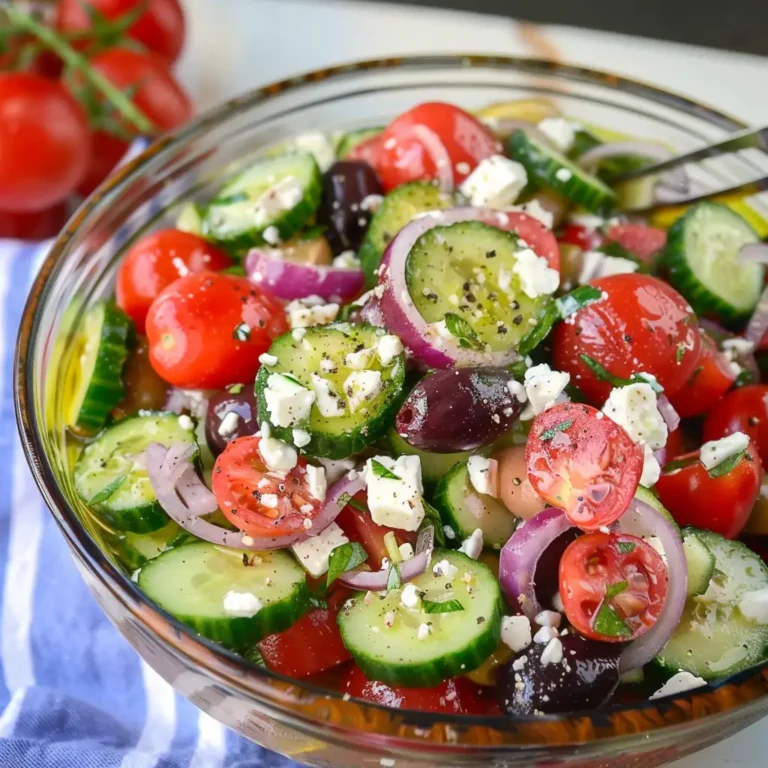Introduction
Greek Salad is a classic Mediterranean dish that is both refreshing and flavorful. This vibrant salad combines ripe tomatoes, crisp cucumbers, tangy red onions, and green bell peppers with briny Kalamata olives and creamy feta cheese. Dressed in a simple yet delicious olive oil and red wine vinegar vinaigrette, this salad is perfect for a light lunch, side dish, or as part of a larger Mediterranean feast. Let’s explore how to make this easy and nutritious Greek Salad.
Overview of the Recipe
Greek Salad is a traditional dish originating from Greece, known for its fresh ingredients and robust flavors. This salad is a great way to enjoy seasonal vegetables and is incredibly simple to prepare. The combination of tomatoes, cucumber, red onion, green bell pepper, Kalamata olives, and feta cheese creates a harmonious balance of flavors and textures, all brought together by a classic olive oil and red wine vinegar dressing.
History and Origin
The Greek Salad, or “Horiatiki Salad,” is a staple in Greek cuisine. Traditionally, it is made with ingredients that are readily available in the Mediterranean region. It is typically served as a side dish, but its hearty ingredients make it filling enough to be enjoyed as a main course. The salad is celebrated for its simplicity and the way it showcases the quality of fresh, local produce.
Ingredients
- 4 large tomatoes, chopped
- 1 cucumber, sliced
- 1 red onion, thinly sliced
- 1 green bell pepper, sliced
- 1/2 cup Kalamata olives
- 200g feta cheese, cubed
- 1/4 cup extra-virgin olive oil
- 2 tablespoons red wine vinegar
- 1 teaspoon dried oregano
- Salt and pepper to taste
Instructions
Step 1: Prepare the Vegetables
- Chop the Tomatoes: Start by chopping 4 large tomatoes into bite-sized pieces. Place them in a large salad bowl.
- Slice the Cucumber: Slice 1 cucumber into thin rounds or half-moons, depending on your preference, and add them to the bowl.
- Thinly Slice the Red Onion: Peel and thinly slice 1 red onion, then add it to the bowl.
- Slice the Green Bell Pepper: Slice 1 green bell pepper into thin strips and add them to the bowl.
Step 2: Add Olives and Feta
- Add the Kalamata Olives: Measure out 1/2 cup of Kalamata olives and add them to the bowl.
- Cube the Feta Cheese: Cut 200g of feta cheese into cubes and add them to the salad.
Step 3: Make the Dressing
- Combine Dressing Ingredients: In a small bowl, whisk together 1/4 cup of extra-virgin olive oil, 2 tablespoons of red wine vinegar, 1 teaspoon of dried oregano, and salt and pepper to taste.
Step 4: Toss the Salad
- Pour the Dressing: Pour the prepared dressing over the salad.
- Toss Gently: Toss the salad gently to ensure all ingredients are evenly coated with the dressing.
Step 5: Serve
- Serve Immediately or Chill: Serve the salad immediately for the freshest taste, or refrigerate it for up to 2 hours to allow the flavors to meld and intensify.
Serving
Greek Salad is best served fresh and chilled. It makes a perfect side dish for grilled meats, seafood, or as part of a larger Mediterranean spread. For a complete meal, pair it with warm pita bread and a selection of dips like tzatziki or hummus.
Pairing and Serving Suggestions
- Grilled Meats: Serve alongside grilled chicken, lamb, or beef for a balanced and flavorful meal.
- Pita Bread: Warm pita bread complements the salad and can be used to scoop up the ingredients.
- Dips: Pair with Mediterranean dips such as tzatziki, hummus, or baba ganoush.
Variations of the Recipe
- Add Proteins: Enhance the salad by adding grilled chicken, shrimp, or even chickpeas for a vegetarian protein option.
- Different Veggies: Include other vegetables like cherry tomatoes, radishes, or roasted red peppers for added variety.
- Herb Mix: Experiment with fresh herbs like mint, dill, or basil for a different flavor profile.
Health Benefits Notes
Greek Salad is not only delicious but also packed with nutritional benefits:
- Tomatoes: Rich in vitamins A and C, as well as antioxidants like lycopene.
- Cucumber: Hydrating and low in calories, cucumbers are a good source of vitamins K and B.
- Red Onion: Contains antioxidants and compounds that support heart health.
- Green Bell Pepper: High in vitamin C and beneficial for immune health.
- Kalamata Olives: Provide healthy fats and antioxidants.
- Feta Cheese: A source of protein and calcium, though it should be consumed in moderation due to its sodium content.
FAQs
Q: Can I make Greek Salad ahead of time?
A: Yes, you can prepare the vegetables and dressing separately up to a day in advance. Combine and toss with dressing just before serving to maintain freshness.
Q: Can I use a different type of cheese?
A: While feta is traditional, you can substitute it with other cheeses like goat cheese or mozzarella for a different taste.
Q: How long can I store Greek Salad in the refrigerator?
A: Greek Salad can be stored in the refrigerator for up to 2 days, though it is best enjoyed fresh.
Q: What can I use instead of red wine vinegar?
A: You can substitute red wine vinegar with lemon juice or white wine vinegar for a slightly different flavor.
Conclusion
Greek Salad is a vibrant and refreshing dish that brings the taste of the Mediterranean to your table. With its fresh ingredients and simple preparation, it’s perfect for any occasion, from casual lunches to elegant dinners. This classic salad not only delights the palate but also offers numerous health benefits. Enjoy making and sharing this easy, nutritious, and delicious Greek Salad recipe with your loved ones!

